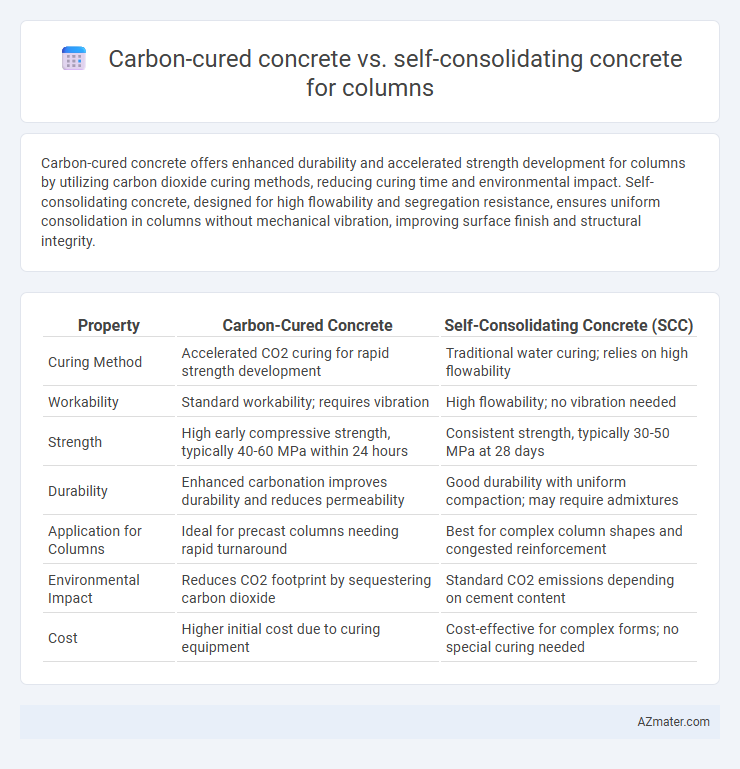Carbon-cured concrete offers enhanced durability and accelerated strength development for columns by utilizing carbon dioxide curing methods, reducing curing time and environmental impact. Self-consolidating concrete, designed for high flowability and segregation resistance, ensures uniform consolidation in columns without mechanical vibration, improving surface finish and structural integrity.
Table of Comparison
| Property | Carbon-Cured Concrete | Self-Consolidating Concrete (SCC) |
|---|---|---|
| Curing Method | Accelerated CO2 curing for rapid strength development | Traditional water curing; relies on high flowability |
| Workability | Standard workability; requires vibration | High flowability; no vibration needed |
| Strength | High early compressive strength, typically 40-60 MPa within 24 hours | Consistent strength, typically 30-50 MPa at 28 days |
| Durability | Enhanced carbonation improves durability and reduces permeability | Good durability with uniform compaction; may require admixtures |
| Application for Columns | Ideal for precast columns needing rapid turnaround | Best for complex column shapes and congested reinforcement |
| Environmental Impact | Reduces CO2 footprint by sequestering carbon dioxide | Standard CO2 emissions depending on cement content |
| Cost | Higher initial cost due to curing equipment | Cost-effective for complex forms; no special curing needed |
Introduction to Concrete Innovations for Columns
Carbon-cured concrete enhances column durability by incorporating CO2 curing processes that improve strength and reduce permeability, aligning with sustainable construction trends. Self-consolidating concrete offers superior flowability and uniformity, ensuring void-free, dense columns without mechanical vibration. Both innovations address critical structural performance, with carbon curing emphasizing environmental benefits and self-consolidating concrete optimizing placement efficiency for load-bearing columns.
Understanding Carbon-Cured Concrete
Carbon-cured concrete enhances column durability by accelerating carbonation, which increases compressive strength and reduces permeability compared to traditional curing methods. It traps CO2 within the concrete matrix, improving environmental sustainability by lowering carbon footprint and enhancing long-term structural performance. This curing technique is especially beneficial for precast columns, promoting rapid strength gain and improved surface hardening.
Overview of Self-Consolidating Concrete
Self-consolidating concrete (SCC) is a high-performance material designed for easy placement without mechanical vibration, ideal for complex column forms and congested reinforcement. Its high flowability and stability reduce labor costs and improve structural uniformity, enhancing the durability and aesthetic finish of columns. Compared to carbon-cured concrete, SCC offers superior workability and faster construction cycles, making it a preferred choice for precision-engineered column applications.
Material Composition and Properties
Carbon-cured concrete incorporates carbon dioxide during the curing process, enhancing its density and compressive strength by promoting calcium carbonate formation, which improves durability and sustainability through CO2 sequestration. Self-consolidating concrete (SCC) features a high cementitious content combined with superplasticizers and viscosity-modifying agents, enabling it to flow and consolidate under its own weight without mechanical vibration, resulting in superior workability and uniformity. While carbon-cured concrete emphasizes carbon capture and increased surface hardness, SCC prioritizes ease of placement and homogeneity, making each suitable for different structural and environmental demands in column construction.
Strength and Durability Comparison
Carbon-cured concrete for columns exhibits enhanced compressive strength due to accelerated carbonation processes that improve cement hydration and microstructure density. Self-consolidating concrete provides superior durability with its highly flowable mix and uniform consolidation, reducing voids and enhancing resistance to cracking and chloride penetration. Strength-wise, carbon-cured concrete can achieve higher early-age strength, while self-consolidating concrete ensures long-term durability through improved homogeneity and reduced permeability.
Workability and Placement Efficiency
Carbon-cured concrete offers enhanced durability and reduced curing time but typically requires skilled labor to achieve optimal workability during placement in columns. Self-consolidating concrete excels in workability due to its high flowability and segregation resistance, enabling faster and more efficient placement without mechanical vibration. For column construction, self-consolidating concrete provides superior placement efficiency, minimizing labor costs and improving surface finish quality.
Environmental Impact and Sustainability
Carbon-cured concrete significantly reduces CO2 emissions by utilizing captured carbon dioxide during curing, enhancing sustainability through carbon sequestration and lower embodied carbon compared to traditional methods. Self-consolidating concrete (SCC) offers environmental benefits by minimizing energy consumption during placement through improved flowability, but it typically involves higher cement content, potentially increasing carbon footprint. For structural columns, carbon-cured concrete supports sustainable construction by combining strength development with environmental impact mitigation, whereas SCC prioritizes labor efficiency and reduced waste, requiring careful mix design to optimize ecological performance.
Cost Analysis and Economic Considerations
Carbon-cured concrete for columns offers reduced curing time and lower energy consumption, leading to potential cost savings in labor and accelerated project timelines. Self-consolidating concrete (SCC) demands higher material costs due to specialized admixtures but reduces formwork and vibration labor costs by improving flowability and placement efficiency. Economic considerations must balance initial material expenses of SCC against the operational cost benefits of carbon-cured concrete's faster strength gain and sustainability advantages.
Application Scenarios in Column Construction
Carbon-cured concrete enhances early strength gain and durability, making it suitable for precast column production where rapid turnaround and carbon footprint reduction are critical. Self-consolidating concrete excels in complex column forms and congested reinforcement scenarios due to its high flowability and ability to consolidate without vibration, ensuring uniformity and surface quality. Selecting between the two depends on project priorities such as environmental impact, formwork complexity, and production speed in column construction.
Conclusion: Choosing the Right Concrete for Columns
Carbon-cured concrete offers enhanced durability and reduced carbon footprint, making it ideal for sustainable construction projects focused on environmental impact. Self-consolidating concrete excels in workability and flowability, ensuring high-strength, void-free columns in complex formworks and congested reinforcement scenarios. Selecting the right concrete depends on structural requirements, site conditions, and sustainability goals, with carbon-cured concrete favored for green design and self-consolidating concrete preferred for precision and ease of placement.

Infographic: Carbon-cured concrete vs Self-consolidating concrete for Column
 azmater.com
azmater.com